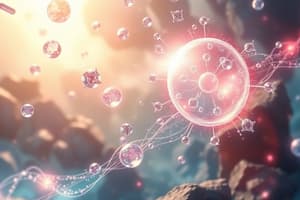Podcast
Questions and Answers
Which of the following best describes a common gastrointestinal side effect of medication?
Which of the following best describes a common gastrointestinal side effect of medication?
- Anaphylaxis
- Renal impairment
- Headache
- Nausea (correct)
What type of drug interaction occurs when two drugs have opposing effects?
What type of drug interaction occurs when two drugs have opposing effects?
- Pharmacodynamic interaction (correct)
- Pharmacokinetic interaction
- Cumulative interaction
- Additive interaction
What is the primary action of ACE inhibitors in pharmacology?
What is the primary action of ACE inhibitors in pharmacology?
- Inhibit ion channel activity
- Facilitate transporter activity
- Alter receptor interactions
- Inhibit enzymes related to blood pressure regulation (correct)
Which phase of pharmacokinetics involves the processing of a drug in the liver?
Which phase of pharmacokinetics involves the processing of a drug in the liver?
Which classification separates drugs based on the potential for abuse?
Which classification separates drugs based on the potential for abuse?
What is meant by bioavailability in pharmacology?
What is meant by bioavailability in pharmacology?
Which of the following is not a common neurological side effect of medications?
Which of the following is not a common neurological side effect of medications?
How do SSRIs primarily function in the body?
How do SSRIs primarily function in the body?
Flashcards are hidden until you start studying
Study Notes
Pharmacology Study Notes
Mechanism of Action
- Definition: The process by which a drug produces its effects in the body.
- Types:
- Receptor Interactions: Drugs bind to specific receptors (e.g., agonists, antagonists).
- Enzyme Inhibition: Drugs inhibit enzymes to alter biochemical pathways (e.g., ACE inhibitors).
- Ion Channel Modulation: Drugs affect the opening/closing of ion channels (e.g., calcium channel blockers).
- Transporter Activity: Drugs block or facilitate the transport of substances across membranes (e.g., SSRIs).
Side Effects
- Definition: Unintended effects of a drug, which can be mild to severe.
- Common Types:
- Gastrointestinal: Nausea, vomiting, diarrhea.
- Neurological: Dizziness, headache, sedation.
- Allergic Reactions: Rash, itching, anaphylaxis.
- Organ-Specific: Liver toxicity, renal impairment.
Drug Interactions
- Definition: Changes in the effect of a drug when taken with another substance.
- Types:
- Pharmacodynamic Interactions: Drugs with similar or opposite effects (e.g., additive or antagonistic effects).
- Pharmacokinetic Interactions: Alterations in absorption, distribution, metabolism, or excretion (e.g., enzyme inducers/inhibitors).
- Clinical Relevance: Can lead to increased toxicity or reduced efficacy.
Pharmacokinetics
- Definition: The study of how drugs move through the body.
- Four Phases:
- Absorption: Process of drug entering the bloodstream (e.g., oral, intravenous).
- Distribution: How the drug spreads throughout the body tissues.
- Metabolism: Biotransformation of the drug, typically in the liver (e.g., phase I and phase II reactions).
- Excretion: Elimination of the drug from the body, primarily through urine or feces.
- Key Concepts:
- Bioavailability: Fraction of administered drug that reaches systemic circulation.
- Half-life: Time taken for the plasma concentration of a drug to reduce by half.
Drug Classification
- Definition: Categorization of drugs based on similar characteristics.
- Common Classifications:
- By Mechanism of Action: e.g., beta-blockers, ACE inhibitors.
- By Therapeutic Use: e.g., analgesics, antibiotics, antihypertensives.
- By Chemical Structure: e.g., steroids, alkaloids.
- Scheduled Drugs: Classification based on potential for abuse (e.g., Schedule I-V in the U.S.).
These notes provide an overview of pharmacology, focusing on the mechanisms, effects, interactions, kinetics, and classifications of drugs.
Mechanism of Action
- Drugs produce their effects through various processes.
- Receptor Interactions: Involve binding to receptors; agonists activate while antagonists block.
- Enzyme Inhibition: Alter biochemical pathways by inhibiting specific enzymes (e.g., ACE inhibitors reduce blood pressure).
- Ion Channel Modulation: Affect ion channels' opening and closing (e.g., calcium channel blockers reduce cardiac workload).
- Transporter Activity: Influence the transport of substances, either blocking or facilitating (e.g., SSRIs enhance serotonin levels).
Side Effects
- Unintended drug effects can range from mild to severe.
- Gastrointestinal Issues: Common side effects include nausea, vomiting, and diarrhea.
- Neurological Effects: Patients may experience dizziness, headaches, or sedation.
- Allergic Reactions: Reactions can vary from mild rashes to severe anaphylaxis.
- Organ-Specific Issues: Some drugs may cause liver toxicity or impair renal function.
Drug Interactions
- Drug effects can change when combined with other substances.
- Pharmacodynamic Interactions: Involve drugs with similar effects (additive) or opposing effects (antagonistic).
- Pharmacokinetic Interactions: Changes in absorption, distribution, metabolism, or excretion due to one drug affecting another (e.g., enzyme inducers speeding up metabolism).
- Interactions may lead to increased toxicity or decreased therapeutic efficacy.
Pharmacokinetics
- Studies how drugs are absorbed, distributed, metabolized, and excreted in the body.
- Absorption: Refers to the process by which drugs enter systemic circulation (e.g., oral vs. intravenous routes).
- Distribution: How drugs spread to various body tissues and their physiological impacts.
- Metabolism: The liver primarily transforms drugs, involving phase I (oxidation) and phase II (conjugation) reactions.
- Excretion: Drugs are eliminated mainly through urine or feces.
- Key Concepts:
- Bioavailability indicates the fraction of the administered drug that reaches systemic circulation.
- Half-life measures the duration for drug concentration in plasma to reduce to half its initial value.
Drug Classification
- Categorizes drugs based on shared characteristics.
- By Mechanism of Action: Groups drugs like beta-blockers and ACE inhibitors based on how they function.
- By Therapeutic Use: Includes classifications such as analgesics for pain relief and antibiotics for infection treatment.
- By Chemical Structure: Various classes like steroids and alkaloids.
- Scheduled Drugs: Classification according to abuse potential, ranging from Schedule I (high potential for abuse, no accepted medical use) to Schedule V (lower potential for abuse).
Studying That Suits You
Use AI to generate personalized quizzes and flashcards to suit your learning preferences.




